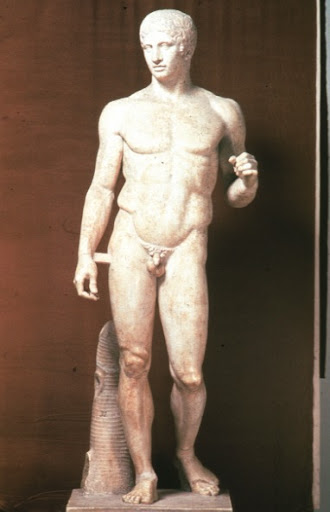The destruction of the Mycenaean palaces was accompanied by the disintegration of the Bronze Age social order and the disappearance of powerful kings led to what was called the Dark Age of Greece, characterized by depopulation, poverty, and an almost total loss of contact with the outside world. During the eighth century the human figure returned to Greek Art, painted on the surfaces of ceramic pots. The Dipylon Krater was a grave marker from the Geometric Period. The artist covered much of the surface with precisely pained abstract angular motifs in horizontal bands. The widest part has two bands of human figures shown as two-dimensional geometric shapes. Their silhouettes are constructed of triangular frontal torsos with attached profile arms, legs, and heads with a single large frontal eye, following the age-old convention. Despite the highly stylized and conventional manner of representation, this vessel marks a significant turning point in the history of Greek art with the reintroduction of the human figure in art.
The Archaic Kouros is patterned after Egytian format. It emulates the stance of Egyptian statues with it's rigidly frontal body with the left foot advanced slightly. The arms are held beside the body in clenched fists. But unlike their Egyptian ancestors, Greek kouros statues were liberated from their original stone block and were nude. In this statue he has a triangular shape of head with stylized hair, flat face, and slim waist. The pointed arch of the rib cage and v shape ridge of the hips suggests the rounded flesh and muscle of the human body. At this time the women were still clothed.

The Early Classical style was characterized by a final break from the rigid and unnatural Egyptian inspired pose of the Archaic kouroi. Kritos boy shows a concern for not just representing the human body, but also shows how it stands with a weight shift in the hips known as contrapposto.

One of the most frequently copied Greed statues from the High Classical Period was Polykleitos's Spear bearer. This is the ideal statue of a nude male athlete or warrior. The contrapposto is more pronounced than ever before and he achieved a system of chiastic or cross balance. This piece also establishes the cannon of proportion shown throughout Greek art.

The Late Classical art took place during the rule of Alexander the Great. Alexander's place has not been excavated, but the sumptuous life of the Macedonian court is clearly evident in the abundance of mosaics uncovered at Pella homes. These mosaics are made of pebbles of various colors collected from beaches and riverbanks and set into a thick coat of cement. Gnosis made one such mosaic called Stag hunt. In ith the light figures against the dark ground ecco red figure painting style. The musculature of the hunters are modeled by shading. Use of light and dark to suggest volume was rarely seen on Greek vases, but were quite common to monumental painters.

The Hellenistic period of art was full of drama and emotion. In Laocoon and his sons, Vergil vividly portrays the strangling of Laocoon and his two sons by sea serpents while sacrificing at an alter. The Hellenistic sculptural portrayal of figures was unlike any Greek figure representation seen before. The figures are dynamic and full of energy in all sorts of poses with accurate musculature and representation of the human form.
No comments:
Post a Comment